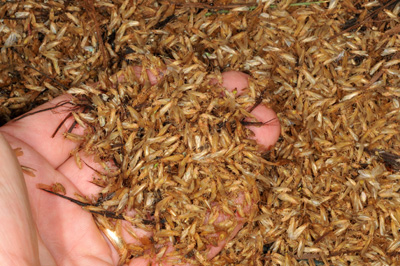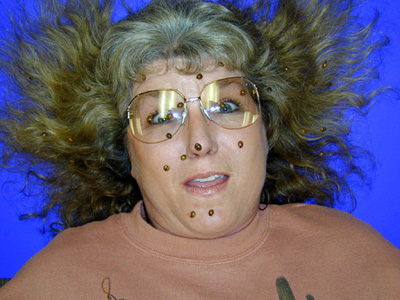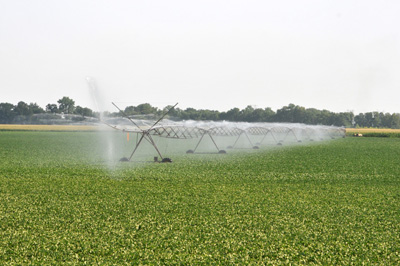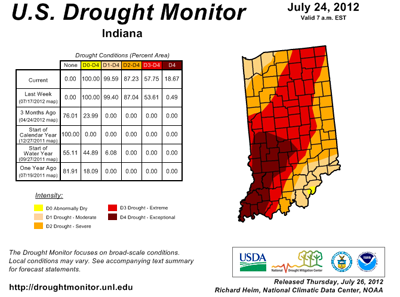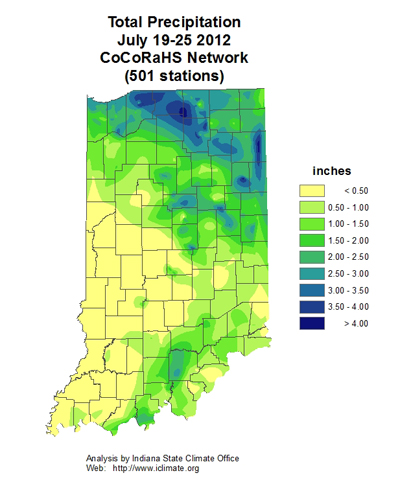Pest & Crop Newsletter, Entomology Extension, Purdue University
- Do Bugs Really Like it Hot?
- Blacklight Trap Catch Report
- Alternatives for Mite Control in Field Corn
- Western Bean Cutworm Adult Pheromone Trap Report
Do Bugs Really Like it Hot? – (Christian Krupke and John Obermeyer)
An article being circulated in the popular news this week (originally appearing in USA Today) indicated that insects were flourishing throughout the country in this year’s record heat. We were contacted by CBS News and asked to comment, and may have disappointed the reporter by not fanning the flames on this particular story. The article featured quotes from several entomologists (mostly professionals in the pest control industry), that explained how insect development is temperature-dependent, so more heat = more bugs. Sounds simple and seems to make sense at first glance. But as many of you know, there is more to the story.
Caddisflies, an aquatic non-pest insect, have been abundant in our black light trap near the Wabash River in Knox County
If you’re an avid Pest&Crop reader, you’ve probably noticed the lack of insect pest related articles lately. Whereas, earlier in the year, we were sharing about the accelerated pace of insect development…most insects running 2-3 weeks earlier than historical calendar dates. Our colleagues in other systems, e.g., horticulture, fruits, vegetables, etc., were experiencing the same phenomenon. We know that if we were to just consider temperature, in general insects will develop more quickly and potentially have more generations in seasons that are warmer.
Of course, insects need more than heat. The lack of moisture that is causing so much concern in our cropping systems is also detrimental to insects – insects need free water to drink in many cases and they get that from standing water, dew and nectar. All are in short supply this year. The USA Today article is really just telling half the story to get the populace to envision massive hordes of mosquitoes, ants and spiders invading their homes. Although there are no hard data to back us up, we actually believe the record heat and drought has caused a dramatic decline in most insects this season, both pests and beneficials. It all starts with healthy, growing plants and those are in short supply in many areas. To put it simply, when crops are stressed, so are the pests that feed on them and their natural enemies.
Are you being driven buggy more in this heat?
Many of you are immediately thinking of one pest that is flourishing in this environment …spider mites. No doubt, in many soybean (and some cornfields), this 8-legged spider relative has shown its incredible reproductive potential in recent weeks. Two-spotted spider mite has been the fodder for our articles, and video, for the past several weeks and with good reason. Past droughts, most recently 1988, have taught us that hot and dry conditions will lead to population explosions of spider mites in field crops and this year is reinforcing that for us all.
All things are relative and experience counts for a lot when reacting to insect populations. When talking with a homeowner today about cicada killers flying around her frightened kids, facts are meaningless. Because she’s never experienced these intimidating (but non-aggressive) flying machines before, I’m certain she’d agree with the premise that insects are “worse” this year! We’re sure it had nothing to do with them recently moving to the country, being surrounded by trees (with cicadas), and recently constructing a soil berm in the backyard. Perfect for the cicada killer, not so for the homeowner.
Click here for the Blacklight Trap Catch Report
![]()
Alternatives for Mite Control in Field Corn – (Christian Krupke and John Obermeyer) -
Two-spotted spider mites have been well-covered by our publication and others in recent weeks. Most of those articles have dealt with soybeans, primarily because mites tend to be more problematic in beans than corn, and soybeans are still more “salvageable” in most areas. However, some irrigated corn fields in northern Indiana are infested with mites as well. One alternative to the organophosphorus insecticides (chlorpyrifos, dimethoate), is a miticide, trade named Comite (active ingredient propargite). Labeled for field and sweet corn, this product is best applied using ground sprayer if possible. Information from our colleagues in the Western Corn Belt certainly indicate that control of this species of mite is optimistic, but with good canopy penetration, should reduce the population enough to get the corn to the dent stage.
![]()
Click here for the Western Bean Cutworm Trap Report
Corn Kernel Abortion After Pollination - (Bob Nielsen) -
Dr. Bob Nielsen, Purdue Extension Corn Agronomist, visits a hot, dry corn field shortly after pollination to determine the success of kernel fill. This stressed corn field did get through pollination fairly well, but now many fertilized kernels are in a process of aborting or shriveling. The moisture level in these plants are so low, that the developing ears are flaccid and rubber-like. At this growth stage, and beyond, one can attempt to estimate grain yield by following procedures in this linked publication: <http://www.agry.purdue.edu/ext/corn/news/timeless/YldEstMethod.html>
![]()
Assessing Soybean for Drought Stress - (Shaun Casteel) -
Dr. Shaun Casteel, Purdue Extension Soybean Agronomist, shows symptoms of drought stress in a R3 growth stage soybean field. He goes through varying degrees of soybean stress, from yellowing of lower leaves to plant death. Most importantly, is how flowers and developing pods are lost, likely leading to yield losses.
![]()
Life on the Edge: The Irrigated Corn Interface Durig Drought - (Bob Nielsen and Shaun Casteel) -
Drs. Bob Nielsen and Shaun Casteel, Purdue Extension Agronomists, visit an irrigated corn field in the midst of a drought. While they transverse the interface from irrigated to moisture-starved corn they make several observations of plant response and the differences in air, leaf, and soil temperatures. This video certainly supports the old adage, "rain makes grain."
![]()
Irrigation Management In Time of Drought – (Lyndon Kelley, MSU Extension Irrigation Educator, Mike Staton, MSU Extension CURE Soybean Educator, and Steve Miller, visiting specialist Bio system and Agricultural Engineering)
Deck: Michigan and Indiana are in midst of the greatest agriculture water challenge seen for decades. Realizing the challenges and modifying Irrigation management allow producer to get the most from the resource available.
Several factors have led to lower summer water table and surface water levels:
- Lack of solid winter freeze which allowed winter precipitation to infiltrate to the aquifer much earlier than normal.
- Lack of winter- spring rainfalls.
- Early spring green up of natural vegetations which reduced recharge season by 3-4 weeks in many areas.
- Continued hot and dry weather depleting water supplies and increasing demand for water.
Most irrigation systems in Michigan and Indiana were designed to supplement summer rainfall and do not have the long term capacity to keep up with drought condition crop water requirements. This can result in yield and quality reduction when water is restricted. The need for water is most critical now. Reducing irrigation to the level that is below basic crops water needs will jeopardize both the investment made on the applied water and purchased crop inputs. Corn exhibits the greatest yield reduction from drought conditions at pollination and the following two weeks.
Soybeans have little yield reduction in when drought conditions occur during the vegetative growth period as long as enough water is available for near normal plant growth. Adequate water is critical through blossom to prevent aborting of developing pods. Greatest yield advantage from irrigation is often achieved from R3 (beginning pod, one pod 3/16 inch long on one of the upper four nodes on the main stem having unrolled leaves) through R6 (full seed, one pod containing green seed that fills the pod cavity on one of the upper four nodes on the main stem having unrolled leaves. Water applied at R3 to R5 encourages flower and pod retention. This increases yield potential by increasing the number of seeds per acre. Irrigation water applied after R5 will primarily improve yields by increasing seed size.
So what can you do as irrigators?
- If your water supply becomes challenged; prioritize your irrigations to the greatest advantage. Limit irrigation to acreage that you can meet crops water needs, giving priority to the most valuable crop at it critical stages.
- Consider rebuilding part of the soil reserve if your water supply allows after limited rainfall events. In fields where crops are showing soil moisture depletion like rolling corn or flipped soybean leaves consider building a reserve by irrigating in excess crop E.T. It may be possible to reduce water applications late in the growing season with minimal impact on yield.
- Maximize the percentage of irrigation water that enters the soil and is available to plant roots. Irrigation water applied at a rate faster than it can infiltrate into the soil can cause runoff. Even if the water does not leave the field it can create under and over irrigated spots. Walk the most venerable sites in your irrigated fields and identify problem areas. Venerable areas have the heaviest (finer textured) soils or most compacted areas. Look for areas were water is applied the fastest by the system, with a focus on near the last tower of a center pivot. If signs of runoff are present, reduce your irrigation application rate. For future year consider changing distribution system to one offering greater wetted areas.
For more information on Avoiding Irrigation Runoff see: <http://www.msue.msu.edu/portal/default.cfm?pageset_id=28706&page_id=361029&
msue_portal_id=25643>
- Maximizing application rates while avoiding runoff. Irrigation water that evaporates directly from the soil or foliage does not effectively meet the plants water needs. During drought condition as much 0.1 inches of each application is caught in foliage and soil upper surface where it evaporates directly to air. Bare soils may have 1.0 to 2.0 inches of topsoil that void root development due to excessive heat. This soil will hold 0.06 to 0.14 inch of irrigation from the plant for each application depending on the type of soil and presents crop residue. An irrigator applying a single 1.5 inch of water instead of three 0.5- inch applications to a soil with a surface that holds 0.1 inches/ inch in the top inch of soil will have saved 0.2 inch of irrigation water.
- Improving uniformity of irrigation system allows all areas within the field receive close to the same amount of water.
Adjust end guns, repair leaks and sprinkler malfunctions to provide as uniform application as possible. Eliminating under- or over-irrigated portion of the coverage area allows closer management of water without jeopardizing yields.
Recent Nebraska research shows minimal irrigation water saving from drop nozzles. These systems greatly increase the potential of irrigation water runoff (because water is applied to a smaller area) and can result in poor uniformity when plant height interferes with distribution pattern.
For more information on test irrigation system uniformity see: <http://www.msue.msu.edu/portal/default.cfm?pageset_id=28706&page_id=361029&
msue_portal_id=25643>
- Verify your actual application by measuring system output over many locations or better yet a complete system evaluation. In testing on over forty systems it was not uncommon for producer’s estimate of application to be 20% different than tested application.
- Plants grown on heavier soils will need as much water as plants in light sandier soils. The crops evapotranspiration needs are the same for the plant. The advantage of heavier soil is that it can store more water so additional water is carried into the summer and larger rainfall events in the summer are more effectively stored. Once the soil moisture is depleted the same amount of irrigation water must be applied to meet crop needs.
- If water supply in drought is not adequate to run the entire system continuously consider pumping for only part of each day thus allowing time to replenish the pumps draw down area or for ponds to recharge. Reduced pumping volumes may allow a continuously lower than normal pumping volume. Close down the supply line valve, shut off the pivot end gun, or reduce big gun nozzle size to adjust system’s application to a lower volume requirement.
- Private ponds can often improve groundwater recharge by cleaning and expanding their area. Water temperature difference in the pond can be used as an indicator cans the direction of recharge. A local excavator with irrigation pond digging experience is often the best resource in deterring potential pond improvements.
- A recharge well is sometimes utilized to pump continuously at a low volume into existing pond to store water for irrigation. Since most existing irrigation ponds normally recharge themselves (they are connected to the aquifer), recharge wells are relatively ineffective as water is circulated back to the aquifer.
- Problems have occurred when impoundments have been created in county drains including blowouts and damage to culverts crossings. Always consult the Drain Commissioner when making changes in a public drain.
- Irrigation scheduling can result in more effective use of the water. See sites below:
For more information on irrigation scheduling see: <http://www.msue.msu.edu/objects/content_revision/download.cfm/revision_id.604557/
workspace_id.-30/#3Scheduling Tools.pdf/> or <http://www.extension.umn.edu/distribution/cropsystems/components/
DC1322_01.html#Checkbook>.
![]()
Answers to Common Questions about Irrigating Soybeans – (Mike Staton, MSU Extension Soybean Educator and Lyndon Kelley, MSU Extension and Purdue Extension Irrigation Educator)
This article will help soybean producers make profitable irrigation decisions.
I have not applied any irrigation water to my soybeans. Will I see an economic return by irrigating them at this point in the season?
Yes, especially if the plants are healthy and irrigation can begin at pod initiation. In general, the most important time to irrigate soybeans is from R3 (beginning pod, one pod 3/16 inch long on one of the upper four nodes on the main stem having unrolled leaves) through R6 (full seed, one pod containing green seed that fills the pod cavity on one of the upper four nodes on the main stem having unrolled leaves). Water applied at R3 to R5 encourages flower and pod retention. This increases yield potential by increasing the number of seeds per acre. Irrigation water applied after R5 (one pod with1/8 inch long seeds on one of the upper four nodes on the main stem with unrolled leaves) is also beneficial as it improves yields by increasing seed size. In fact, if soybeans can be watered only one time during the growing season, it should be at R5.
I began irrigating my soybeans in June to get them through the drought. Can I stop watering them now that we have received some rain?
You may be able to delay irrigation water applications due to recent rain but plan to apply irrigation water as necessary through seed fill (R6). Failure to continue irrigation may cause more stress on the crop than if no irrigation water had been applied. This is because soybean plants are able to adjust to soil moisture conditions by changing pod number and seed size. Plants may produce fewer and smaller seeds if irrigation is discontinued. The earlier irrigation applications may have also reduced rooting depth. Monitor moisture levels in the top two feet of soil closely and maintain the moisture level above 60% of the available water holding capacity throughout R6.
When can I stop irrigating soybeans without sacrificing yield?
Research from the University of Missouri showed that terminating irrigation too soon can cause yield losses of ¾ of a bushel per acre per day on a sandy soil. The Missouri researchers made the last application around September 20th which was well into the R7 growth stage. However, most universities recommend timing the final irrigation run so that the soil moisture level is near 60% of the available water holding capacity at the beginning of the R7 growth stage.
Precise timing of all irrigation runs, including the final run, requires a working knowledge of basic irrigation scheduling concepts such as the amount of water required for soybeans at various growth stages to reach maturity, available soil water capacity, allowable water depletions, soybean growth stages, effective rooting depth and estimating soil moisture status. Lyndon Kelley and Steve Miller have compiled a list of Irrigation Scheduling Tools <http://www.msue.msu.edu/objects/content_revision/download.cfm/revision_id.604557/
workspace_id.-30/%233%20Scheduling%20Tools.pdf/> that explain and utilize these concepts.
This article was produced by the SMaRT project (Soybean Management and Research Technology). The SMaRT project was developed to help Michigan producers increase soybean yields and farm profitability. SMaRT is a partnership between MSU Extension and the Michigan Soybean Checkoff program.
![]()

